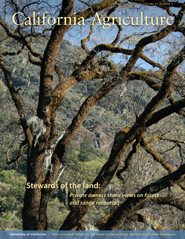All Issues

Stewards of the land: Private owners share views on forest and range resources
Cover:
About 34 million acres (42%) of California’s forests and rangelands are privately owned. A new survey of these landowners found that most value the land for its natural amenities and as a financial investment, rather than primarily for income production. Photo of valley oak, Hopland: Laurence R. Costello
October-December 2011
Volume 65, Number 4
Volume 65, Number 4





